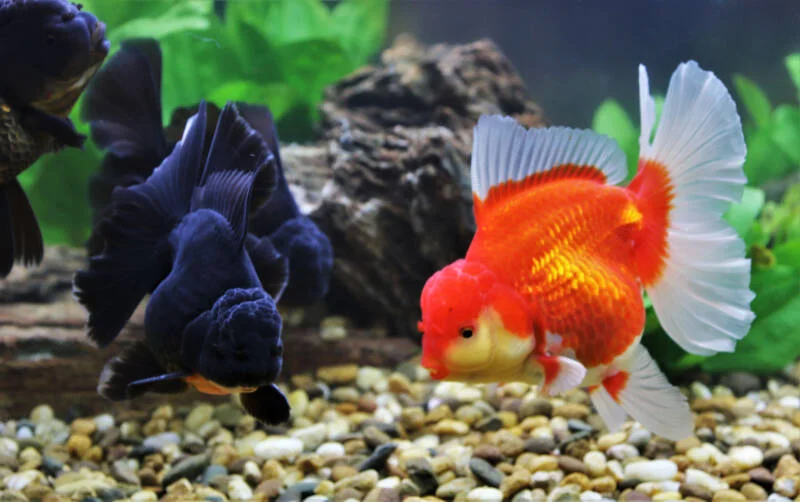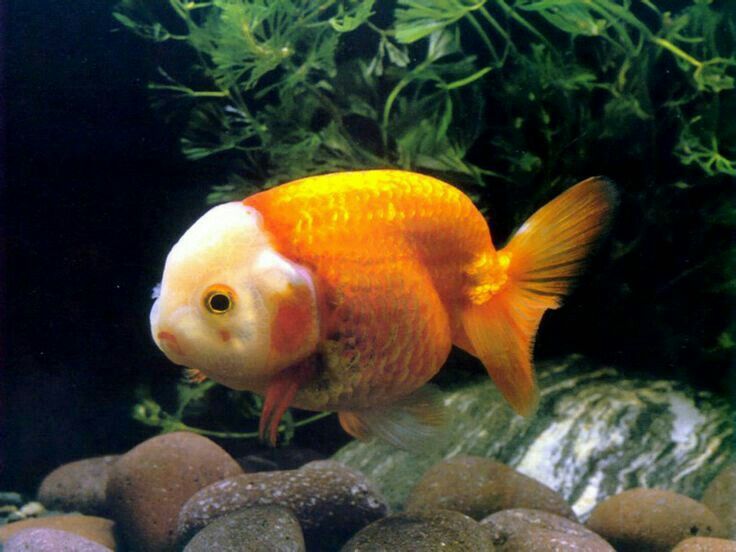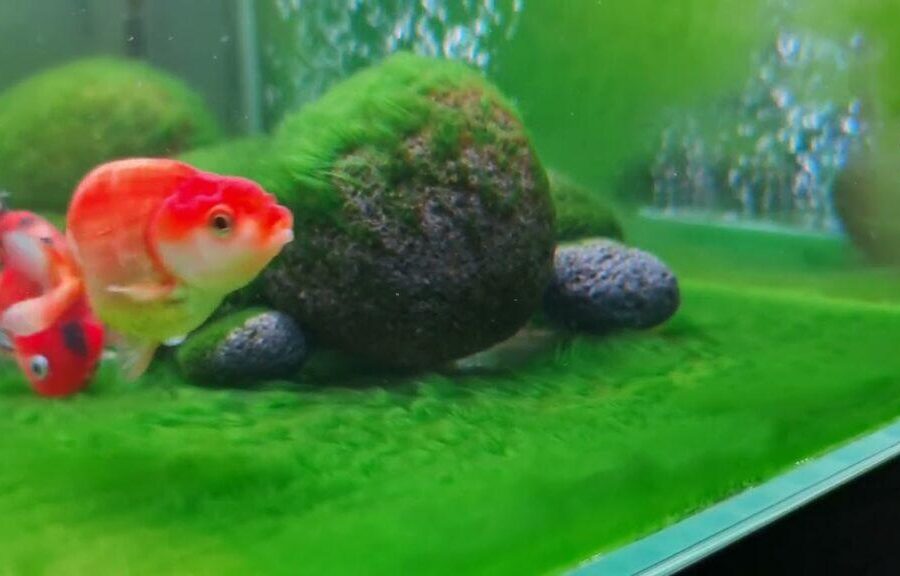
Hello there, fellow baby goldfish enthusiasts! Have you recently become the proud parent of some adorable baby goldfish, or seen your goldfish family grow with new offspring? Or perhaps, you’re considering diving into the fascinating world of goldfish parenthood? Either way, it’s crucial to grasp the fin-essentials of feeding baby goldfish. Yes, those little, googly-eyed, fluttery-tailed cuties need a specific diet to grow into splendid, vibrant adults. You know, the kind that would make even the most fancy-pants peacock blush with envy!
Importance of Proper Nutrition for Baby Goldfish Growth
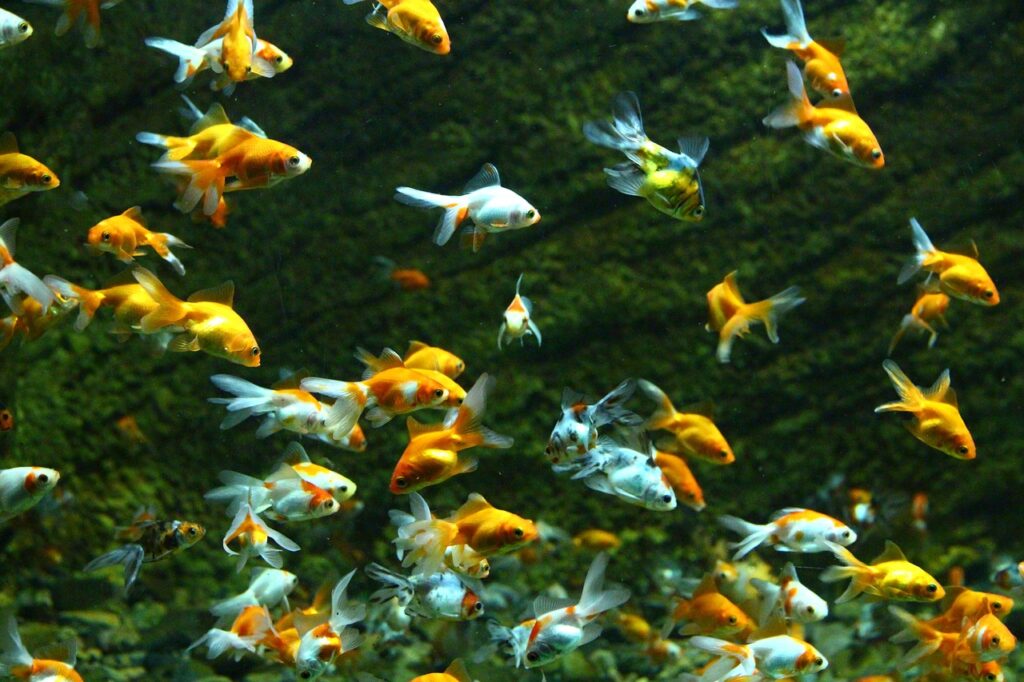
Just like little human nippers, baby goldfish or ‘fry’ as the fish fanatics fondly refer to them, need a specific diet for their growth. Because let’s face it, you can’t trade off their future flamboyance for a few cheese puffs, now, can you? Feeding them properly ensures they receive all the necessary nutrients to develop their beautiful multi-colored coats, enhance their overall health, fortify their immune systems, and fulfill their…shall we say…gold destiny.
Nutrition plays such an integral role that it can even affect their lifespan (hey, we all want our golden buddies to outlive the family cat); hence, it isn’t something we can skim over like skipping an ad on YouTube. So strap in for a deep dive into the realm of goldfish gastronomy!
Common Misconceptions about Feeding Baby Goldfish

Now before we swim ahead, it’s vital to debunk some fishy (pun completely intended!) misconceptions concerning the baby goldfish diet. For starters, goldfish are not walking (or swimming?) garbage disposals. In contrary to popular belief, they cannot subsist healthily on everything or anything you throw into their tank. Being bottom feeders doesn’t mean absorbing all the thrown peels and tabs; your fish needs actual nutrition, people!
Another glaring myth is that goldfish only need to be fed once a day. Well, come on, would you like to have just one meal a day? Exactly. This misconception could make your goldfish crave for food and light a hunger strike underwater (Not a pretty sight, trust me!)
Alright, so now that we’ve busted some beliefs and set the record straight, in the next section, we’ll dive, or rather, happily paddle through the nutritional needs of your baby goldfish. So, hold onto your diving masks and let’s deep dive!
Understanding Baby Goldfish Nutritional Needs

Before we get candid about the specifics of the baby goldfish diet, let’s remind ourselves of a universal truth: nutrition is a saint. It’s crucial for absolutely everyone and every creature – including your fascinating baby goldfish. Getting it right in this early stage sets the stage for growth, health, and let’s not forget – them wowing you with bright, poppy colors. So, what are the nutritional necessities for these cuties? Let’s find out!
Protein Necessities for Baby Goldfish
Meat lovers, rejoice – your pet is one of you. Baby Goldfish are high-performance athletes in their own water-filled sphere. Meaning, They need loads of protein – the building blocks for muscles, to keep them sprinting from one end of the tank to the other.
The two P’s – Protein and fish growth are as chummy as Peanut butter and jelly. A diet near to around 40-50% of high-quality protein is ideal for these growing champs. Now, you may wonder – “Where do I get those proteins?” Well, fear not. It’s simpler than you think. Foods like brine shrimp, daphnia, and even high-quality goldfish flakes can provide the necessary protein for your fishy friend.
Vitamin and Mineral Requirements
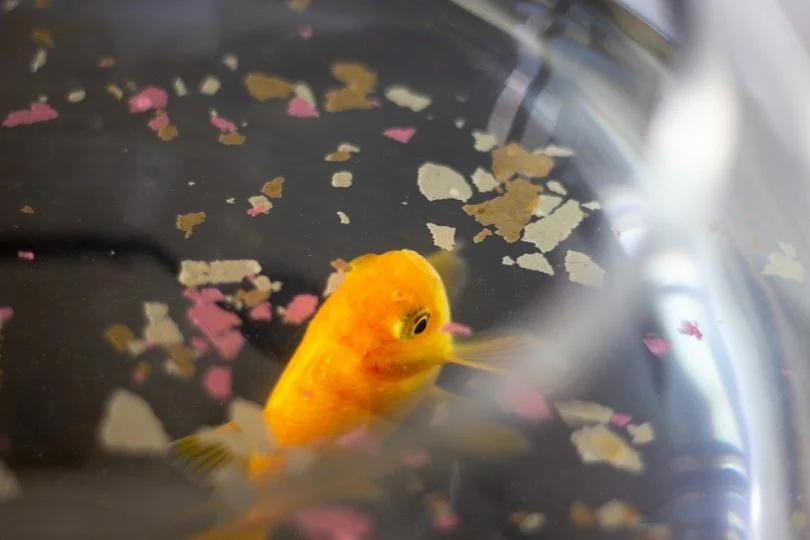
Like a multivitamin pill supplements our diet, baby goldfish also need essential vitamins and minerals in theirs. We are not talking about turning your tank into a fishy version of Popeye by throwing in spinach, but yes, vitamins A, B, C, D, E and K, along with minerals like iron, are necessary for their health and vitality.
Vitamin C contributes to a healthy immune system. Vitamins A and B are essential for the proper functioning of their metabolic system. But guess what, commercially available fish food typically includes these essentials.
The Balance of Vegetables and Meat in Their Diet
“Vegetables? To a goldfish?” you may ask. Yes indeed! Baby goldfish can be voracious meat eaters, but, they oscillate between carnivore and herbivore tendencies. Your meat-and-veggie balanced diet for them checks off two significant needs at once. It provides adequate protein for growing bodies, and also keeps their digestive system running smoothly.
Some of the best vegetable options include peas (without the shell), spinach, lettuce, and broccoli – cooked, of course — they aren’t into crunching on raw veggies.
A combination of protein-rich food with a sprinkle of veggies here and there is the gold(ed) standard in ensuring a robust and hearty baby goldfish growth.
As we leap and bound into our next section, let’s simmer a bit on the feeding schedule for these little glubs. It’s about finding the Goldilocks zone – not too much, not too little, but just right. This balance is vital in keeping your fish in optimal health. So, don’t let the current sweep you away. Stay with me, we are diving into the feeding schedule next!
Feeding Schedule for Baby Goldfish

You know the saying, “Scheduling is key”? Well, that holds as true when it comes to feeding a baby goldfish as it does to getting your toddler to bed (though, truth be told, managing a fish might be slightly easier). A well-structured feeding routine ensures your goldfishy munchkin is getting the proper nutrients, promoting its growth and general aquatic happiness.
Determining Feeding Frequency
Now, you may be wondering, “How often do I need to brace myself for meal times?” The answer isn’t quite as straightforward as “three square meals a day”. Unlike us humans, baby goldfish are growth-bomb powerhouses, which means they’re best served with small portions of food but more frequently. That’s right, folks! Diners are open roughly 3 to 4 times a day. Remember, the goal is not to stuff them but to maintain a steady supply of energy. And fear not! They consume food equivalent to the size of their eye. Who knew eyes could also be stomach gauges?
Avoiding Common Feeding Mistakes
As aspiring goldfish parents, it’s essential to understand that overfeeding is not a show of love. Love is helping them keep their tiny home clean, and overfeeding does just the opposite. It leads to untidy tanks due to excessive waste and uneaten food, often resulting in poor health and shorter lives. Your goldfish’s smile (metaphoric, of course) should be lasting not quick and snappy.
Another common pitfall is feeding them “fast food”. Now we’re not saying your goldfish has been frequenting the local Mcdonalds, but quick-to-grab, low-nutrition foods are a no-no. Consider providing a balanced diet using guidelines from section 2 to keep them shining and swimming.
Understanding Their Hunger Signs
People often mistake goldfish’s enthusiastic greeting, or belly-baring begging episode as signs of hunger. Moreover, goldfish are opportunistic feeders – they’d take every opportunity to feast, regardless of actual hunger. Here’s a news flash (or perhaps a splash): Your finned friend isn’t always famished! It’s just their way of saying, ‘Hey, do we see a floating meal ticket up there?’ So, use your parental instincts, learn to distinguish between their longing looks, and stick to a balanced feeding schedule.
With this guidance in tow, you’re now equipped against most feeding pitfalls and are one step closer to achieving the title of ‘Goldfish Whisperer’. But there’s more to baby goldfish care than feeding schedules. Next up, we’re taking a look at some of the best food for our golden babies!
Best Foods for Baby Goldfish
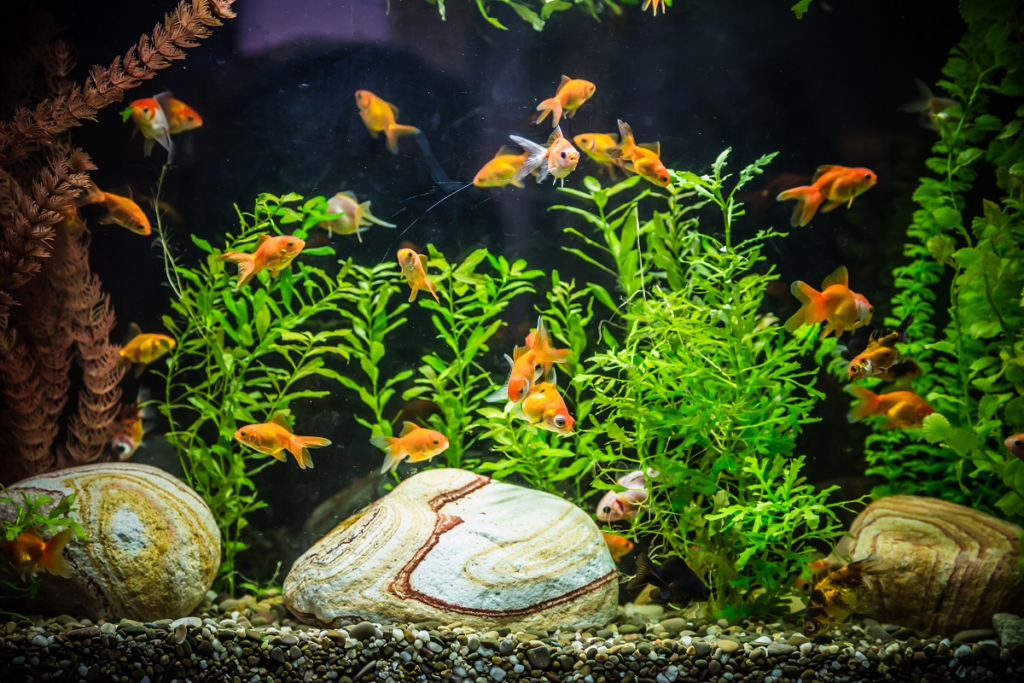
For our little aquatic tykes, food isn’t just about satisfying their rumbling little bellies. It’s a major contributory factor to their health, growth and vibrancy. Heck, if they had dating apps, their profiles would read: baby goldfish, likes sunken castles, tiny plants, and a diet rich in essential nutrients. So, it’s safe to say that when it comes to feeding, there’s more than just dusting off an old jar of flakes. Let’s dive in, shall we?
Commercially Available Baby Goldfish Food
When it comes to convenience and assurance of well-rounded nutrition, commercial baby goldfish foods top the list. “Goldfish Tropical Flakes” and “TetraFin Goldfish Crisps” are both excellent choices since they have been specially formulated to meet the nutritional needs of your little water buddies.
Pros: Commercial food is easy to store and feed. It also provides balanced nutrition to ensure your fish are getting everything they need in one tiny, tasty morsel.
Cons: The downside? These products can be pricey compared to alternative homemade feeds. It’s also not as much fun for your baby goldfish. Imagine eating the same meal every day (flavorless Christmas turkey springs to mind).
Preparing Homemade Goldfish Food
Maybe you’re the Martha Stewart of the fish world and fancy rustling up something in your kitchen? Homemade food like spinach or pea puree, boiled eggs (just the yolk), or cooked fish (ironic, but they love it) can be great feed for your baby goldfish. Moreover, hatching brine shrimp for baby goldfish is also a great idea.
Pros: It offers a variety of flavors, improves their color, enhances their growth and keeps them active. Plus, there’s a joy in watching them devour what you’ve lovingly prepared. Daytime goldfish cookery show, anyone?
Cons: On the flip side, not all homemade meals pass the baby goldfish nutritional requirements test. So, do your homework before serving up any home-cooked goodness. Also, remember that these foods decompose faster thereby increasing the risk of polluting the tank.
Suitable Treat Options for Baby Goldfish
If you’re in the mood to spoil your aqua babies, throwing in a treat once in a while can keep things interesting for them. Fresh fruits like oranges or strawberries, or veggies like cooked peas or lettuce leaves, are great for this purpose while also introducing different textures and flavors into their diet.
Pros: They are a fun and healthy variation from their regular meals.
Cons: Overfeeding with treats can lead to nutritional imbalance and a dirty tank, so remember – moderation is key!
Now, mastering baby goldfish cuisine is one thing, but how do you tell if they’re actually benefiting from their five-star meals? Let’s navigate the signs of proper nutrition in baby goldfish, and yes, it involves closely examining your glittery gold subjects. Keep swimming, folks!
Signs of Proper Nutrition in Baby Goldfish

Do you often wonder if your baby goldfish is hitting the nutritional jackpot with every tiny morsel of food that they gobble up? As an attentive and loving goldfish parent, it’s natural to want to ensure that your little golden baby is getting the right balance of goodies, leaving them as perky as a puppy with a squeaky toy. The truth is, signs of a proper nutritional diet go beyond a simple wag of their tail…or in this case, a swish of their fins.
Physical Indications of A Well-fed Baby Goldfish
Recognizing a well-fed baby goldfish is much like realizing that Aunt Bertha has eaten one too many holiday cookies – all the signs are there, loud and clear. Perhaps your baby goldfish isn’t as plump as Aunt Bertha, but it’s still glowing like a golden nugget in your fish tank. A well-fed baby goldfish should have bright and vibrant colors, clear eyes, and a smooth, healthy skin and fin structure.
Let’s not forget about the ever-important poop! Yes, a healthy well-fed baby goldfish’s poop should be long, golden brown and usually breaks off into segments (just the kind of thing you want to envision while sipping your morning coffee). Additionally, fins should be erect and plump- not like a deflated pool float after a rough pool party.
Before we shift to the behavioral cues, here’s a friendly reminder – despite their miniature size, baby goldfish share the qualities of their larger gene pool. They are resilient creatures and can survive even with less than ideal nutrition. But hey, we’re not aiming for “just surviving,” are we? We want radiant and thriving goldfish!
Behavioral Signs of A Properly Nourished Baby Goldfish
Now that we have the physical features down and you’re loosening up on the Aunt Bertha comparisons, let’s dive into the behavior of a properly nourished baby goldfish. Trust me, their behavior certainly beats your neighbor’s cat’s 3 AM “I’m bored” serenades.
A properly nourished baby goldfish should be active and lively, similar to a toddler hopped up on birthday cake. They will be enthusiastically swimming around, exploring their surroundings, and engaging with other goldfish in the tank. Remember, each goldfish has a unique personality, and your goldfish is the life of the ocean–or, the fish tank–party!
Feedings should be a fiesta for your baby goldfish. A well-nourished baby goldfish will be eager and energetic when food hits the water. It’s a bit like when you unleash a group of hungry kindergarteners on a lunch buffet – fast and frenzied!
By now, you’re probably an expert in detecting the signs of a properly nourished and well-fed goldfish. You’ve graduated from Goldfish Nutrition 101 and the future of your little swimmer is looking brighter and shinier than ever! So, as we sail into the conclusion of this article, just remember– the care you put into feeding will reflect in the life your goldfish leads.
Surround them with love, feed them with care, and watch your baby goldfish steal the show in your fish tank! Stay tuned because up next, we are wrapping things up with some crucial tips for your goldfish parenting journey.
Final Thoughts
We’ve reached the end of our delightful quest through the realm of infant goldfish nourishment. We’ve dispelled common fallacies, explored the intricate facets of goldfish diets, and even examined feeding timetables and premium nourishment choices for your aquatic pals.
Nutrition Essentials for Baby Goldfish
As a recap, remember that our tiny finned buddies, like us, need a comprehensive diet comprising proteins, vitamins, minerals, and a mix of veggies and meat. It’s crucial to heed their hunger cues to maintain a balanced feeding routine. We learnt about the benefits of both off-the-shelf and homemade food alternatives. The key indicators of a robust, well-nourished goldfish are vibrant hues, active swimming and, if we may add, cheerful bubble-blowing!
Key Takeaways and Additional Guidance
Ensuring your goldfish’s nutrition is right is a golden task, but you’re now equipped to take it on like a champion. Remember, each feeding moment is a chance to provide care and affection for your goldfish. Stick to a consistent feeding routine and stay observant. Allow your fondness for them to radiate in the form of gleaming, nutritious flakes!
Before we sign off, a final piece of advice: keep monitoring your goldfish’s behavior. Any irregular swimming or color alterations could hint at dietary shortcomings or other health concerns. To learn more about this, it would be beneficial to read our guide on How to Take Care of Baby Goldfish?
So, put on your sailor’s cap and joyfully navigate through the waters of baby goldfish upbringing. Here’s to you and your goldfish, prospering in the seas of Well-fed and Healthy!
Frequently Asked Questions (FAQ)
Question 1: Why is proper nutrition important for my baby goldfish?
Answer: Proper nutrition is crucial for your fish’s healthy growth, boosts their immune system, and helps them maintain bright and shiny colors.
Question 2: How often should I feed my baby goldfish?
Answer: Baby goldfish should ideally be fed small amounts several times a day, as opposed to adult goldfish that can be fed less frequently.
Question 3: What are some common misconceptions about feeding baby goldfish?
Answer: Some common misconceptions include that goldfish only eat plants, they can survive on bread crumbs, or that they should be fed only once a day.
Question 4: Can I prepare homemade food for my baby goldfish?
Answer: Yes, homemade food like boiled peas, lettuce, and finely chopped seafood can be used, but it’s important to ensure they are given the right balance of nutrients.
Question 5: What are the signs that my baby goldfish is well-fed and properly nourished?
Answer: Physical signs include a smooth, shiny scales, proper growth rate, and bright colors. Behavioral signs include active swimming, frequent exploration, and normal waste production.
Question 6: What are suitable treat options for my baby goldfish?
Answer: Suitable treats include things like brine shrimp, daphnia, and freeze-dried worms, which can replicate their natural diet and provide a nutritious boost.
Question 7: What common feeding mistakes should I avoid?
Answer: Common mistakes include overfeeding, feeding large chunks food that can choke the fish, and not maintaining a balanced diet.
Question 8: Are commercially available baby goldfish foods any good?
Answer: Commercial foods like flakes, pellets and specific baby goldfish formula can be very good as they are often specifically balanced for goldfish dietary needs. However, varying their diet with treats and homemade foods can also be beneficial.

